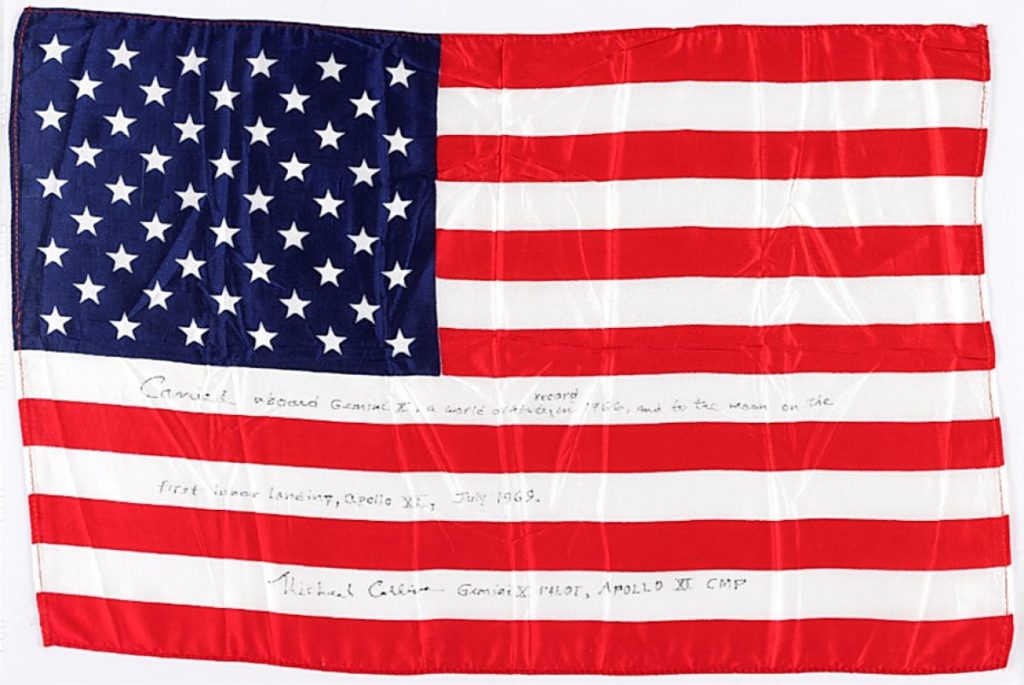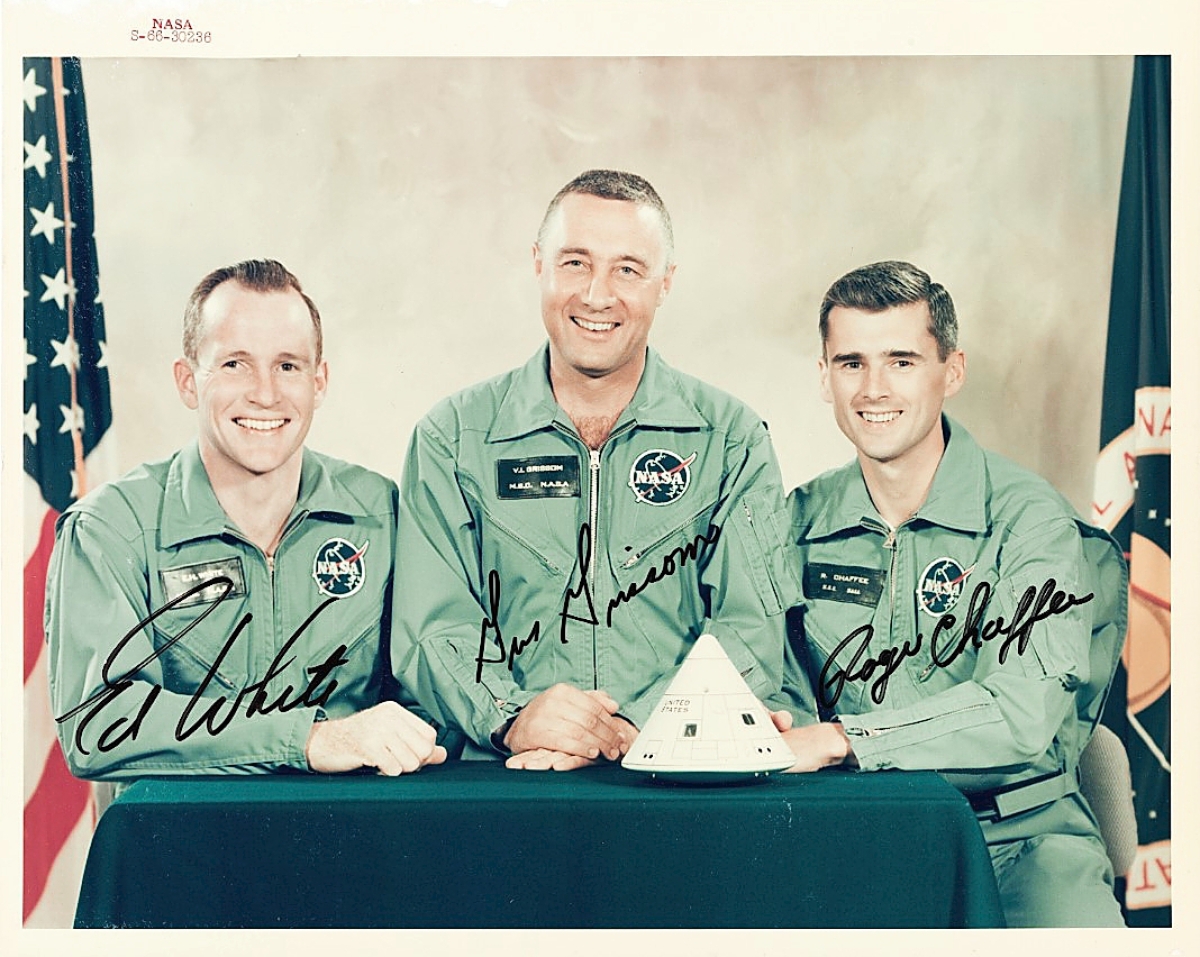
This $300,000 silk American flag was the largest size flown on the Apollo missions and signed by Michael Collins.
Review by Z.G. Burnett, Photos Courtesy of Heritage
DALLAS – The Space Exploration Signature auction on December 15 and 16 was a true journey for buyers and collectors of space memorabilia. More than 1,200 lots were offered during the two-day auctions, which sold for a combined total of $2,257,832. Multiple five- and six-figure sales contributed to this sum, the majority of which were part of the Gemini and Apollo missions.
Flags were especially prominent in the highest selling lots, including the top price of the auction, an Apollo 11 and Gemini 10-flown American flag for $300,000. The silk flag was signed and certified by command module pilot Michael Collins and, at 17½ by 11½ inches, is the largest size typically flown by Apollo missions. Kept by Collins as a treasured souvenir, the flag was also Collections Authentication Guarantee (CAG) certified and encapsulated, showing only creases from being folded. This was one of three distinctive American flags of the upper lots; another signed, 6-by-4-inch flag from the Collins collection that was carried on the Apollo 11 mission achieved $68,750 as well as a second, largest size 17½ by 11½ that once belonged to lunar module pilot Colonel Jim B. Irwin from the Apollo 15 mission, which bid to $32,500.
Beta cloths, swatches of Fiberglass Beta textiles used in spacesuits, also ranked highly in the upper lots. The second most expensive object in the sale was an Apollo 11-flown flag signed by Neil Armstrong, Buzz Aldrin and Michael Collins, who designed its insignia, sold for $106,250. Another beta cloth from Collins’s collection, showing the United Nations flag, sold for $13,750, and a mounted collection of a small flown Apollo 10 flag, an Apollo 17 beta cloth and lunar module flown LM lunar surface checklist from Gene Cernan’s collection achieved $16,200. Flown textiles overall did well, including a mounted Skylab (S-L3) flown cuff checklist attached to a curved metal wristband and tether segment for $40,000. Following this in price was Collins’ personal preference kit, again signed and certified by its former owner, from the Apollo 11 flight that achieved $37,500.
From the Soviet Space Program, a complete Sokol (Falcon) Type KV-2 pressurized IVA “rescue” spacesuit, manufactured by NPP Zvezda, was the only Russian lot included in the highest sales and sold for $30,000. These suits have been used since 1980 by all Russian cosmonauts who fly on the Soyuz spacecraft and was made to keep the wearer alive during an accidental cabin depressurization. Included with the spacesuit is an elasticized protective cover for the visor, what may be the original black nylon carrying bag, and two snap-on rubber protective covers for the wrist holes when the suit is stored. Although the suit was lightly used either from space travel or training, it was still an excellent display item.

Photograph of the ill-fated Apollo 1 crew, signed by members Ed White, Gus Grissom and Roger Chaffee, bid to $18,750.
Space-flown ephemera was also popular with bidders. Two Gemini 4-flown notebooks from the collection of mission command pilot Jim McDivitt (1929-2022) bid to $50,000 and $30,000, and two type one, crew-flown and signed quarantine covers of the Apollo 11 achieved $28,750 and $26,250. Also from the McDivitt collection was a signed Apollo 9-flown “Launch T[ransposition] D[ocking] & E[xtraction] Checklist” book that closed at $27,500. Also from Collins was a signed and certified page from a Apollo 11-flown command module pilot book that went for $22,500. The most eye-catching of this category was an exceedingly rare microform King James Bible encased in a 24K gold, bejeweled reliquary inscribed “First Lunar Bible,” which flew on the Apollo 14 mission. It ascended to $25,000.
Photography and film were also offered in the sale. The most tragic example of this was a 1967 NASA “red number” Kodak color photo of the Apollo 1 crew, signed by all three members. It shows the astronauts posed in their flight suits at a table behind a model of the original CM-012 command module. Originally designated AS-204, the first mission in the Apollo manned lunar landing program was scheduled for launch on February 21, 1967, but a fire during a “plugs-out” launch simulation on January 27, 1967, claimed the lives of the men aboard. The chilling photograph achieved $18,750.
More elevating was the “first selfie in space” of Buzz Aldrin during Gemini 12 extravehicular activity (EVA). This was the last flight of the Gemini program, and it was crucial that astronauts could work on exterior spacecraft issues, something that had not yet been perfected. Buzz Aldrin made a (then) record three EVAs on this flight; two were “stand-up” and one was tethered. The photograph was originally from Aldrin’s collection but unsigned, and sold for $13,750. Two film reels, one from the Apollo 16 and the other Apollo 17, also sold to effect for $9,688 and $13,750.
Prices quoted with buyer’s premium as reported by the auction house. Bidding will open for Heritage Auctions’ next Historical Memorabilia sale, The Gilded Age: Property From the Collection of Richard Watson Gilder and Helena de Kay Gilder American Art Signature auction, on January 20. For additional information, www.historical.ha.com or 214-409-1425.




























